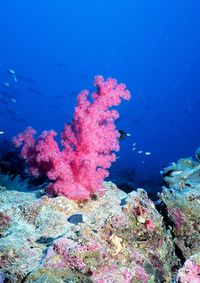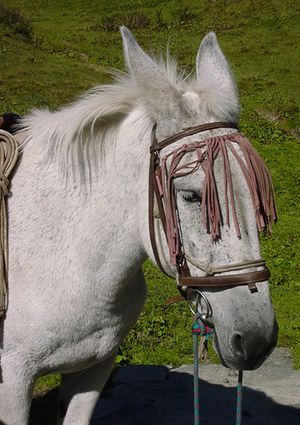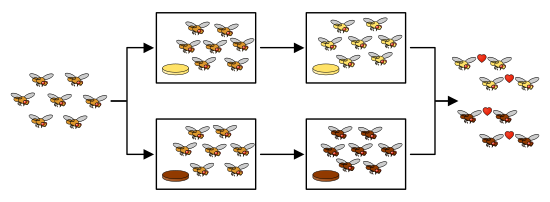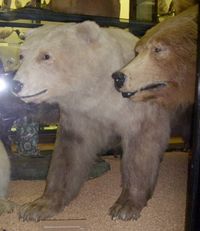انعزال تكاثري
انعزال تكاثري Reproductive isolation، هو فصل مجموعة من شعب نوع population species عن المجموعات الأخرى له، وبالتالي لا يحدث انسياب جيني بينهما. وتميل هذه المجموعةالمفصولة لأن تصبح أكثر تمزيا مع الزمن.[1]
آليات العزلة التي تحدث قبل التزاوج أو الجماع (قبل لاقحي العزلة)
موطن العزلة
العزلة الجنسية بسبب سلوك أو تصرف
The songs of birds, insects and many other animals are part of a ritual to attract potential partners of their own species. The song presents specific patterns recognizable only by members of the same species, and therefore represents a mechanism of reproductive isolation. This recording is the song of a species of cicada, recorded in Lower Hutt, New Zealand on 15th February 2006.
العزلة الميكانيكية

The flowers of many species of Angiosperm have evolved to attract and reward a single or a few pollinator species (insects, birds, mammals). Their wide diversity of form, colour, fragrance and presence of nectar is, in many cases, the result of coevolution with the pollinator species. This dependency on its pollinator species also acts as a reproductive isolation barrier.
000
انعزال عرسي

In coral reefs, gamete incompatibility prevents the formation of numerous inter-species hybrids.
آليات العزلة التي تحدث بعد تكاثر أو الجماع (post-zygotic isolation)
Zygote mortality and non-viability of hybrids
Hybrid sterility

Mules are hybrids with interspecific sterility.
آليات متعددة
هجين بين الجنسين (قاعدة هالدين)
The genetics of reproductive isolation barriers
Pre-copulatory isolation mechanisms in animals
آليات الانعزال الجماعي أو الإخصابي في الحيوانات
آليات الانعزال الإخصابي في النباتات
عدم التوافق التي تسببها الكائنات الحية الدقيقة
تحديد الانعزال التكاثري
| Generation | Percentage of hybrids |
|---|---|
| 1 | 49 |
| 2 | 17,6 |
| 3 | 3,3 |
| 4 | 1,0 |
| 5 | 1,4 |
| 10 | 0,6 |

Reproductive isolation mechanisms can be a consequence of allopatric speciation. A population of Drosophila was divided into sub populations that were selected to adapt to different food types. After a number of generations the two sub populations were mixed again. It was observed that the subsequent matings occurred between individuals belonging to the same adapted group.[3]
انظر أيضا
الهوامش
a. ^ The DNA of the mitochondria and chloroplasts is inherited from the maternal line, i.e. all the progeny derived from a particular cross possess the same cytoplasm (and genetic factors located in it) as the female progenitor. This is because the zygote possesses the same cytoplasm as the ovule, although its nucleus comes equally from the father and the mother.[4]
قائمة المراجع
- Barton N., Bengtsson B. O. (1986), "The barrier to genetic exchange between hybridising populations", Heredity 57 (3): 357–376, doi:, PMID 3804765.
- Barton N., Hewitt G. M. (1985), "Analysis of hybrid zones", Annual Review of Ecology and Systematics 16 (1): 113–148, doi:.
- Baker H G (1959), "Reproductive methods as factors in speciation in flowering plants", Cold Spring Harb Symp quant Biol 24: 177–191, PMID 13796002.
- Grant V (1966), "The selective origin of incompatibility barriers in the plant genus Gilia", Am Nat 100 (911): 99–118, doi:.
- Grant K, Grant V (1964), "Mechanical isolation of Salvia apiana and Salvia mellifera (Labiatae)", Evolution 18 (2): 196–212, doi:.
- Grun P, Radlow A (1961), "Evolution of barriers to crossing of self-incompatible and self-compatible species of Solanum", Heredity 16 (2): 137–143, doi:.
- Jain S K, Bradshaw A D (1966), "Evolutionary divergence among adjacent plant populations. I. The evidence and its theoretical analysis", Heredity 21 (3): 407–441, doi:.
- Mayr, E. 1963. Animal species and evolution. Harvard University Press, Cambridge.
- McNeilly T (1967), "Evolution in closely adjacent plant populations. III. Agrostis tenuis on a small copper mine", Heredity 23 (1): 99–108, doi:.
- Stebbins G L (1958), "The inviability, weakness, and sterility of interspecific hybrids", Adv Genet 9: 147–215, doi:, PMID 13520442.
- Strickberger, M. 1978. Genética. Omega, Barcelona, España, p.: 874-879. ISBN 84-282-0369-5
- Casares, P. 2008. Genética de poblaciones y evolutiva. Capítulo 17. Genética del aislamiento reproductivo. Universidad de Oviedo, España.[5]
المصادر
- ^ عبد الجليل هويدي، محمد أحمد هيكل (2004). أساسيات الجيولوجيا التاريخية. مكتبة الدار العربية للكتب.
- ^ خطأ استشهاد: وسم
<ref>غير صحيح؛ لا نص تم توفيره للمراجع المسماةKoop - ^ خطأ استشهاد: وسم
<ref>غير صحيح؛ لا نص تم توفيره للمراجع المسماةDodd - ^ خطأ استشهاد: وسم
<ref>غير صحيح؛ لا نص تم توفيره للمراجع المسماةStrickberger - ^ Información de la asignatura
This article contains content from Wikimedia licensed under CC BY-SA 4.0. Please comply with the license terms.
